Nearly 80 Gnaw-ty Beavers Move to Wilder Neighborhoods

“As discussed below, many landowners want to remove nuisance beavers from their property. And, when they do, they often turn to trappers, some of whom now turn to Wyoming Wetlands Society for payment — and to get the beavers off their hands.
NOTE: this article was originally published to JHNewsandGuide.com. It was written by Billy Arnold. Photography by Kathryn Ziesig
As Cody Pitz picked up the cage, the small, toothy rodent giving him the stink eye inside emitted a noticeable “pffft.”
After months of working with beavers, the sound caught Pitz’s ear.
“The other thing they do as a defense mechanism is they fart really loudly,” said Pitz, the biologist who coordinates the Wyoming Wetlands Society’s beaver relocation program. “I haven’t read that anywhere, but I haven’t heard them doing that when they’re just doing their thing. It’s only if I approach them.”
The flatulent 30- or 40-pound matriarch of seven did not, however, dissuade the two approaching men from picking up her cage. Pitz and Tag Abel, another Wyoming Wetlands employee, had good intentions. They wanted to give her and her brood a better shot at life by moving them from a less suitable home on private property to the Game Creek drainage in the Bridger-Teton National Forest.
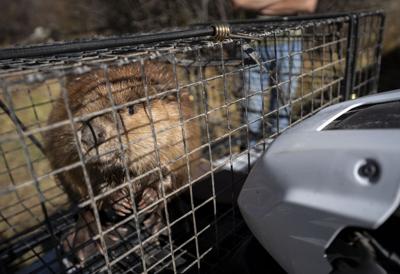
After being transported from the Wyoming Wetlands Society’s headquarters to a Game Creek trailhead, the beavers were strapped onto an ATV for the final leg of their journey before being released. – KATHRYN ZIESIG / NEWS&GUIDE
There, they hoped the rodent family would have a chance to stretch their jaws and dig their yellow incisors into willows without fear of being killed by an upset landowner. In the right place, beavers can have a litany of environment-enhancing effects on the landscape. When beavers dam streams, which they do to give themselves enough cover from predators, they cause water to pool behind their levees. That gives water more time to soak into depleted aquifers, restore wetlands and create natural breaks for wildfire. But, in the wrong place — a backyard, or a ranch, say — beavers can be a real headache. They can clog culverts, or tear down stands of beloved, decades-old aspens or willows. When they do, they’re often killed.
That’s what the Wyoming Wetlands Society is hoping to prevent and has been working to do for the past 15 years. But, this year, the number of beavers they relocated soared: about 75, more than double what’s typical. That’s because they’re working with a handful of private trappers who have agreed to attempt to live trap rather than lethally trap beavers they’re called to remove. The trappers then sell the beavers to the Wetlands Society for about $300 a head. Then, working with researchers, the Bridger-Teton National Forest, and Wyoming Game and Fish Department, the Wetlands Society relocates them on the forest.
The goal is to allow beavers to do what beavers do best: Slow down water and rejuvenate watersheds.
That’s something Todd Stiles, Jackson district ranger for the Bridger-Teton, said he’s seen for himself in Dry Cottonwood Creek, where Wyoming Wetlands Society has been relocating beavers for years.
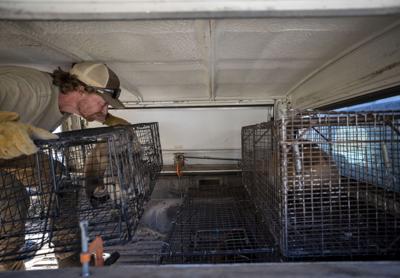
Carrying two young beaver siblings, Wyoming Wetlands Society biologist Cody Pitz stacks the bed of his truck full of nine beavers to transport them to Game Creek. – KATHRYN ZIESIG / NEWS&GUIDE
That, Stiles said, has created a lot of habitat. He’s also felt the drop in stream temperatures below dams on the creek, a possible benefit to cold water fish species like cutthroat trout.
“It felt like it was five, six, 10 degrees cooler,” Stiles said. “And then it’s just green.”
While the west becomes more arid as temperatures rise and snowpack declines, as predicted in the Greater Yellowstone Climate Assessment, the beaver curious see them as a way to mitigate some of those changes.
“With climate change and the risks we’re seeing with more extreme drought and extreme temperatures, beavers can do a lot of things that are really beneficial,” Pitz said.
A geologist by trade, Jeff Burrell, northern Rockies program coordinator for the Wildlife Conservation Society, got into working with beavers by trying to figure out what makes watersheds healthy.
“It was just night and day in terms of watersheds with beavers and watersheds without beavers,” he said.

Two young beavers huddle together in their temporary home as Pitz and Abel prepare to move them into a transport cage. – KATHRYN ZIESIG / NEWS&GUIDE
Now, he’s working with Grand Teton National Park and the Bridger-Teton to survey where beavers live now in Jackson Hole — and where they did in the past. That work is informing where the Wyoming Wetlands Society is relocating beavers. If there’s signs that beavers lived somewhere 50 years ago, Burrell and Pitz said, there’s a good chance they’d adapt well to that environment now. Relocations aside, Burrell said that much of the geology in the valley between the Tetons and Gros Ventres was likely formed by beavers.
“You can tell that very easily because of the flat nature of the valley floor,” Burrell said. “That valley floor is not naturally a flat thing in terms of mountain watersheds. That only occurs because over thousands of years, beavers were capturing sediment and building up that valley floor.”
The plethora of beavers that occupied Jackson Hole before western colonization largely disappeared due to eras of large-scale commercial trapping, Burrell said.
While there are now fewer beavers on the landscape, they’re still finding their way onto private property, including around the town of Jackson. Wyoming Untrapped and other groups in the area have been working to educate homeowners about how to protect their property from the unwanted side effects of the toothy rodents: Wrapping valuable trees with wire, fencing off culverts to prevent beavers from clogging them, and putting hoses in beaver dams to allow water to pool but stop it at a desired level.
Still, landowners often want to remove the beavers. And, when they do, they often turn to trappers, some of whom now turn to Wyoming Wetlands Society for payment — and to get the beavers off their hands.
Relocation and removal isn’t always straightforward, Pitz said. For one, moving beavers from one place to another doesn’t mean that they won’t become a nuisance to another private property owner.
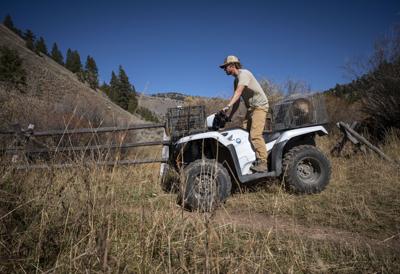
With two cages of beavers secured to his ATV, Pitz starts down the trail at Game Creek. – KATHRYN ZIESIG / NEWS&GUIDE
Standing over cages lined up along Game Greek, readying the family for release, Pitz acknowledged: “There’s people that live downstream from this creek.”
Relocation is also difficult on the animals. Beavers don’t always take well to being removed from their homes and introduced to new ones. When beavers are released individually rather than in family groups, and aren’t released near deep enough water to provide cover from predators while they build dams, survival rates can be as low as 20%. But, if beavers are released in family groups and in suitable habitat, more beavers will survive, though still a relatively low proportion: About 40 to 60%, Pitz said.
In Game Creek, the situation was a mixed bag. On one hand, Pitz was releasing a full family group. But he also was releasing two younger rodents that had gotten separated from their family in a capture that wasn’t successful. The matriarch and patriarch of that beaver clan weren’t found.
By socializing the young beavers with the matriarch of the intact family, Pitz was hoping for success.
Still, he was nervous about putting those two beavers into a potentially hazardous situation.
People critical of relocation latch onto survival numbers as reasons to avoid it, and instead persuade people to find a way to cohabitate with beavers on their property. But landowners often want the beavers gone. Killing them is the easiest way to do that.
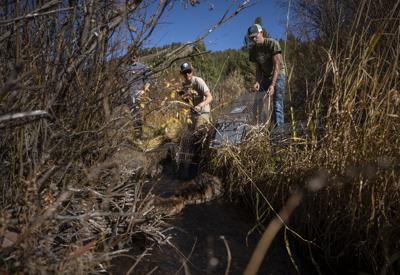
After opening all the cages, pointed downstream, Pitz and Tag Abel watch as nine relocated beavers venture into their new home in Game Creek. – KATHRYN ZIESIG / NEWS&GUIDE
“The science says that young ones don’t do great during a release,” Pitz said. “But I try to remember that most people are going to have them killed otherwise.”
In Game Creek, Pitz scouted where he was releasing the beavers twice. From old chew, he knew that other beavers had lived there. And he was aware of beavers living just upstream. Downstream of the release site was deeper current with a few pools on the bends (a place for beavers to hide if predators approached) and either an old, washed out beaver dam — or a few logs that were stuck.
”It’s a perfect place for them to build a dam,” Pitz said.
Beyond finding deep water and releasing them in family groups, Burrell, the Wildlife Conservation Society researcher, said that giving beavers a leg up with existing dam-like material also helps their long-term success. That’s particularly true as the climate warms and spring runoff happens faster than it once did.
“Now it all crashes through fairly rapidly,” Burrell said. “And they have a hard time dealing with that. Their dams are not designed to handle flash floods at that scale.”
So releasing them in areas with natural dam-like features or building well-anchored dams for them improves their chance of survival — and impacting a landscape.
That sort of help, Burrell said, will be necessary to help the species recolonize former habitat.
Burrell said he’s been surveying some of the areas where Wyoming Wetlands has release beavers. He doesn’t have specifics about the number of beavers successfully living in relocation areas yet because he hasn’t finished surveying those areas. But he’s seeing signs of success.
For example, beavers are now living in Bacon Creek and the upper part of Ditch Creek, where before relocations restored the species they were “absent for decades,” Burrell said.
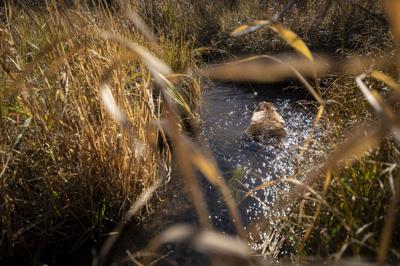
Following her release, a mother beaver swims through Game Creek and into her new territory. – KATHRYN ZIESIG / NEWS&GUIDE
Repopulating the valley’s floor with beavers probably isn’t the greatest call, Burrell said.
“Flooding Jackson Hole is probably not something that’s going to be very popular,” he said. “But we can put beavers in areas where we want them to be and they’ll be very successful.”
And, as Pitz watched the family of beavers swim down the creek after unlocking their cages and setting them free, he was cautiously optimistic for their chances. That included the younger duo released with the larger family of dam-building, water-slowing, habitat-expanding rodents.
“Hopefully away from people, they can make some dams and do some good things,” Pitz said.
—
For more posts like this, in your inbox weekly – sign up for the Restoring Diversity Newsletter
